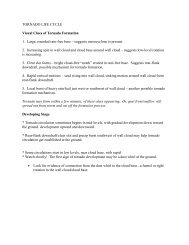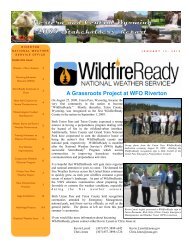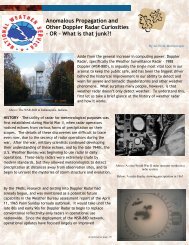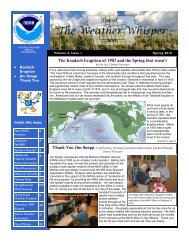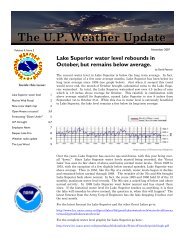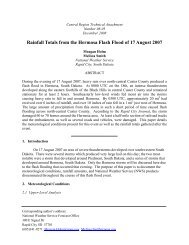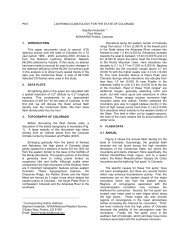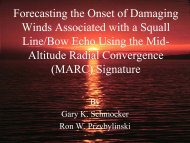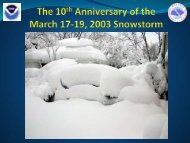Basic Spotters' Field Guide - Skywarn
Basic Spotters' Field Guide - Skywarn
Basic Spotters' Field Guide - Skywarn
You also want an ePaper? Increase the reach of your titles
YUMPU automatically turns print PDFs into web optimized ePapers that Google loves.
NATIONAL OCEANIC AND ATMOSPHERIC ADMINISTRATION<br />
BASIC SPOTTERS’ FIELD GUIDE<br />
BASIC SPOTTERS’ FIELD GUIDE<br />
BASIC SPOTTERS’ FIELD GUIDE<br />
BASIC SPOTTERS’ FIELD GUIDE<br />
U.S. DEPARTMENT OF COMMERCE<br />
U.S. DEPARTMENT OF COMMERCE<br />
National Oceanic and Atmospheric Administration<br />
National Weather Service<br />
NOAA PA 97050
Cover Photo - National Severe Storms Laboratory
BASIC SPOTTERS’ FIELD GUIDE<br />
U.S. DEPARTMENT OF COMMERCE<br />
National Oceanic and Atmospheric Administration<br />
National Weather Service
NATIONAL OCEANIC AND ATMOSPHERIC ADMINISTRATION<br />
TO THE SEVERE LOCAL STORM SPOTTER:<br />
SEVERE WEATHER!!! Its effects are felt by many of us during our lifetimes. To obtain critical weather information, the<br />
National Weather Service of the U.S. Department of Commerce’s National Oceanic and Atmospheric Administration, and<br />
cooperating organizations, have established SKYWARN Spotter Networks. Although SKYWARN spotters are essential<br />
information sources for all types of weather hazards, your largest responsibility as a SKYWARN spotter is to identify and<br />
describe severe local storms. In the average year, 10,000 severe thunderstorms, 5,000 floods, and over 900 tornadoes occur<br />
across the United States. During the past 10 years, tornadoes, severe thunderstorms, and flash floods have killed nearly<br />
2,300 people in the United States and injured thousands of others. Because of storm spotter reports, such as those you<br />
provided, plus the addition of new technology and improved warning dissemination, this death toll was reduced by more<br />
than 800 from the previous 10 years. While the figures still appear staggering, several thousand lives have been saved by<br />
reports from storm spotters.<br />
Your information, coupled with Doppler radar, satellite, and other data, has enabled the National Weather Service to issue<br />
more timely and accurate warnings for tornadoes, severe thunderstorms, and flash floods. This guide has been designed to<br />
assist you in the important task of observing and reporting hazardous weather and protecting yourself during your<br />
encounters with hostile weather situations. I am pleased that you are part of the ranks of those who form the Nation’s first<br />
line of defense against severe weather. There can be no finer reward than to know that your efforts have given a community<br />
the precious gift of time...seconds and minutes that can save lives.<br />
Sincerely,<br />
Susan F. Zevin<br />
Deputy Assistant Administrator for Operations<br />
U.S. DEPARTMENT OF COMMERCE
Use of this <strong>Guide</strong>:<br />
The information contained in this guide is provided as a reference to supplement the National Weather Service’s spotter training film and<br />
slide series. It is not sufficient to qualify you as a SKYWARN spotter. This guide has been compiled for use by trained spotters in the field<br />
(both fixed and mobile spotters) and communication specialists who receive and relay the reports. The safety tips contained in this guide<br />
are geared primarily for mobile spotters, but the technical concepts that are outlined are applicable to spotters of all types. This guide is<br />
not a general handout for the public. As a result of its specialized subject matter, a number of technical terms are used. Their meanings are<br />
explained in the text. Many of the photos used in this guide were taken in the Great Plains area of the United States where visibilities usually<br />
are good. Spotters in other areas of the country, especially the southern states, may have difficulty seeing some of the thunderstorm’s<br />
features because of poor visibility caused by terrain, trees, heavy rainfall, or low clouds.<br />
Definitions and Terminology<br />
Severe local storms occur in all parts of the continental United<br />
States in an average year. As part of their training, storm spotters<br />
should be aware of severe storm definitions and terminology used by<br />
the National Weather Service.<br />
Watch — Conditions are favorable for the severe weather event in<br />
or near the watch area. Watches are issued for tornadoes, severe<br />
thunderstorms, and flash floods.<br />
Warning — The severe weather event is imminent or occurring in<br />
the warned area. Warnings are issued for tornadoes, severe<br />
thunderstorms, flash floods, and river flooding.<br />
Tornado — A violently rotating column of air attached to a<br />
thunderstorm and in contact with the ground.<br />
Funnel Cloud — A rotating, funnel-shaped cloud extending<br />
downward from a thunderstorm base.<br />
Downburst — A strong downdraft with an outrush of damaging<br />
wind on or near the ground.<br />
Flash Flood — A rapid rise in water, usually within 12 hours of a<br />
period of heavy rain or other causative agent (i.e., dam break).<br />
Severe Thunderstorm — A storm that produces hail 3/4 inch in<br />
diameter or larger and/or wind gusts of 58 mph or more.
Severe Weather Reporting Criteria<br />
Many types of weather information are needed from storm<br />
spotters; however, some types of information are much more<br />
important than others. Strict adherence to the reporting criteria<br />
allows vital information to be communicated as soon as possible.<br />
Also, some of the reporting criteria should receive higher priority<br />
communication than others. You should report the following weather<br />
events.<br />
Urgent Priority<br />
Tornado<br />
Funnel cloud<br />
Rotating wall cloud<br />
Flash flooding<br />
High Priority<br />
Hail 3/4-inch diameter or larger<br />
Wind speed greater than 58 mph<br />
Persistent non-rotating wall cloud<br />
Rainfall 1 inch or more per hour<br />
Lower Priority<br />
Hail 1/2-inch diameter or larger<br />
Wind speed greater than 40 mph<br />
Cloud features suggesting storm organization<br />
Other locally-defined criteria<br />
Receiving Hazardous Weather<br />
Information<br />
Spotters, both point and mobile, should have access to reliable<br />
hazardous weather information. Many spotters have access to<br />
amateur radio networks. These networks will likely have one or more<br />
radio operators stationed at NWS offices for providing radar and other<br />
meteorological information to the net. Spotter networks not affiliated<br />
with amateur radio groups should consider having one or more<br />
members monitor NOAA Weather Radio and other outlets for weather<br />
information. These networks may wish to select a liaison person who<br />
could work with nearby amateur radio groups or the local NWS office.<br />
Another means of receiving hazardous weather information is the<br />
Emergency Managers Weather Information Network (EMWIN). EMWIN<br />
is a low-cost, low-speed data stream of NWS products (warnings,<br />
observations, etc.) provided as a service to local emergency managers.<br />
The signal may be received directly from the GOES weather satellites,<br />
processed for local use, and/or rebroadcast to the surrounding area on<br />
VHF radio. Numerous EMWIN systems are coming on line across the<br />
country, which should allow both point and mobile spotters access to<br />
critical NWS information. This in turn should allow for more efficient<br />
operation of spotter networks in the area.<br />
NOTE: When reporting 1/2-inch diameter hail, do not use the term<br />
“marble” since marbles can come in a variety of sizes. In areas prone<br />
to severe weather, some offices may not need reports of 1/2-inch hail.<br />
Contact your local NWS office for specific adjustments to the criteria<br />
suggested above.<br />
1
Thunderstorm Hazards and<br />
Safety Tips<br />
Flash Floods<br />
Flash flooding is a major killer. Many flash floods occur at night,<br />
which makes them more difficult to see. As a storm spotter, you may<br />
encounter flash floods at any time. Heeding the following flash flood<br />
safety rules may save your life.<br />
• DO NOT attempt to drive or walk across a flooded roadway<br />
or low water crossing. Nearly half of all flash flood deaths are<br />
vehicle-related. Moving water 2 feet deep will carry away<br />
most cars.<br />
• If your vehicle becomes caught in high water and stalls, leave it<br />
immediately and seek higher ground if you can do so safely.<br />
Rapidly rising water may sweep a vehicle and its occupants<br />
away.<br />
• Be especially careful at night when flash floods are harder<br />
to recognize.<br />
Lightning<br />
Lightning occurs in all thunderstorms and is also a significant<br />
threat to life (figure 1). Storm spotters are especially vulnerable to<br />
being struck by lightning since they are often in prime strike<br />
locations, such as in open fields or on hilltops. The following<br />
lightning safety rules are important.<br />
• Lightning tends to strike the tallest object in an area...make sure<br />
it is not you. Remain in your vehicle or an indoor location<br />
whenever possible.<br />
• If you must go outside, crouch down to make yourself a poor<br />
lightning target. Do not lie flat on the ground since you will<br />
be more likely to be severely shocked if lightning strikes<br />
close to you.<br />
Figure 1: Cloud-to-ground lightning. Photo - Courtesy Roger Edwards.<br />
2
Hail<br />
Although large hail rarely causes fatalities, it is the most destructive<br />
element associated with severe local storms and can cause considerable<br />
property damage (figure 2). If the storm you are observing produces<br />
a tornado, it will likely form very near the shaft of large hail.<br />
• Keep a firm grip on your vehicle’s steering wheel to maintain<br />
control. Wind speed and direction can change rapidly in a<br />
downburst.<br />
• Blowing dust or heavy rain may accompany downbursts. Be<br />
prepared for sudden changes in visibility that may create<br />
hazardous spotting conditions.<br />
• Point spotters observing from a substantial building should<br />
move away from windows as the downburst approaches.<br />
Figure 2: Hail Damage. Photo - Courtesy James Purpura.<br />
These hail safety tips can help minimize damage to your vehicle and<br />
possible injury to you.<br />
• Substantial structures and highway overpasses (out of traffic<br />
lanes) offer the best hail protection.<br />
• Hard-top vehicles offer fair protection from hail up to about golf<br />
ball sized, but significant windshield and auto body damage can<br />
result with hail larger than golf balls.<br />
Tornadoes<br />
Tornadoes pose a significant threat to all spotters. High winds and<br />
flying debris can result in hazardous spotting conditions and<br />
significant damage to vehicles and buildings (figure 3). Be especially<br />
alert for tornadoes when storm spotting. These safety rules could<br />
save your life.<br />
• Mobile spotters in high visibility areas, such as open rural areas,<br />
may be able to drive away from an approaching tornado.<br />
REMEMBER, THIS DOES NOT APPLY TO SPOTTERS IN URBAN<br />
AREAS, INEXPERIENCED SPOTTERS, SPOTTERS IN LOW<br />
VISIBILITY LOCATIONS SUCH AS IN HEAVILY WOODED AREAS,<br />
OR MEMBERS OF THE GENERAL PUBLIC. Spotters should be<br />
familiar with their area and have a planned escape route.<br />
Downbursts and Outflow Winds<br />
A downburst is defined as a strong downdraft with an outrush of<br />
damaging wind on or near the ground. Downbursts are responsible for<br />
most thunderstorm wind damage. Winds may exceed 100␣ mph in very<br />
strong downbursts (see figures 14 and 15). The following downburst<br />
safety rules are important.<br />
Figure 3: Tornado. Photo - © Alan Moller.<br />
3
• If you can’t avoid an oncoming tornado, you should take shelter<br />
in a substantial building, ditch, ravine, or other low spot (but be<br />
cautious of flash flooding).<br />
Safe Viewing Tips<br />
Mobile spotters should try to view a storm from its right flank.<br />
This will usually provide the best viewing angle, the best contrast, and<br />
it will generally keep spotters out of the storm’s path. For storms<br />
moving to the northeast, the best viewing location is from the south<br />
or southeast. With east or southeast moving storms, a viewing angle<br />
from the south or southwest (respectively) is preferred although<br />
spotters will need to be more conscious of the storm’s movement and<br />
have an escape route available.<br />
Thunderstorm Life Cycle<br />
All thunderstorms, whether they become severe or not, proceed<br />
through a 3-stage life cycle.<br />
a. Cumulus Stage (figure 4) — Occurs when thunderstorm<br />
development begins. At this stage, the storm consists only of<br />
updrafts (upward-moving air currents). These updrafts reach heights<br />
of around 20,000 feet above the ground. In the western United States,<br />
the development stage may begin as higher based altocumulus<br />
clouds. As moisture becomes more plentiful, the base of the storm<br />
may lower.<br />
b. Mature Stage (figure 5) — This is the strongest and most<br />
dangerous stage of the storm’s life cycle. At this stage, the storm<br />
contains both upward and downward moving air currents (updrafts<br />
and downdrafts) with precipitation in the downdraft area. The<br />
downdraft results from precipitation evaporating, which causes<br />
cooling. To a lesser extent, the falling precipitation itself creates<br />
downward drag. When the cool downdraft hits the ground, it spreads<br />
out and forms a gust front, which may include damaging winds called<br />
a downburst. At the top of the storm, the updraft rapidly decelerates<br />
and clouds spread out and form an anvil. If the updraft is strong, a<br />
“bubble” of cloud, called an “overshooting top,” will be pushed above<br />
the anvil. Spotters should pay particular attention to a storm with an<br />
overshooting top since the area beneath the top is a preferred area<br />
for severe weather formation.<br />
c. Dissipating Stage (figure 6) — Eventually, excessive precipitation<br />
and downdraft will weaken the updraft. Downdrafts dominate the<br />
storm and any overshooting top disappears. At the surface, the gust<br />
front will move away from the storm and cut off the inflow of energy<br />
into the storm. This is indicative of the dissipating stage.<br />
Figure 4: Towering cumulus stage of a thunderstorm.<br />
Figure 5: Mature stage of a thunderstorm.<br />
Figure 6: Dissipating stage of a thunderstorm.<br />
4
Depending on the type and number of cells, thunderstorms may be<br />
divided into four main categories:<br />
• Single-cell storms are generally weak, short-lived, and poorly<br />
organized. “Pulse storms” are strong single-cell storms and thus<br />
are quite rare.<br />
• Multicell cluster storms are the most common type of storm and<br />
consist of a series of cells moving along as one unit.<br />
• Multicell line storms, commonly called “squall lines,” consist of<br />
a long line of storms with a continuous gust front at the leading<br />
edge.<br />
• Supercell storms have a single updraft, are very strong, and<br />
always produce significant severe weather. (See figure 7 for<br />
additional information about each type of thunderstorm. These<br />
thunderstorm types will be discussed in more detail in the<br />
advanced storm spotter’s training program.)<br />
Visual Indications of Updraft Strength<br />
and Organization<br />
Several visual clues will help the spotter determine if a storm has<br />
severe weather potential. These clues are evident in the upper,<br />
middle, and lower levels of the storm. The spotter should pay<br />
particular attention to these clues, especially when watching more<br />
than one storm at a time.<br />
a. Upper-Level Storm Clues — These clues are best seen at a<br />
distance of 30–40 miles from the storm, so they may be difficult to see<br />
in poor visibility areas. The primary clues are a large overshooting<br />
top that persists for more than 10 minutes and an anvil with sharp<br />
and well-defined edges (figure 8). Storms with weaker updrafts will<br />
usually have an anvil that is thin, wispy, and fuzzy.<br />
Figure 7: Overview of the thunderstorm spectrum, with characteristics of each<br />
primary storm type.<br />
Figure 8: Distant supercell storm showing upper-level visual clues of storm strength.<br />
Photo - Courtesy Bill Martin.<br />
5
. Mid-Level Storm Clues — These clues are best seen at a distance<br />
of 10–20 miles from the storm, and again, some of these features will<br />
be difficult to see in poor visibility areas. These features are<br />
concentrated in the main storm tower area. The primary clues are the<br />
following.<br />
• A solid appearing updraft tower with a sharp, cauliflower<br />
definition in the storm tower (again, see figure 8). Some storms<br />
have a soft or “mushy” appearance indicative of a weaker<br />
updraft and therefore are a poor candidate for producing severe<br />
weather (figure 9).<br />
• A flanking line — a row of small cloud towers that build up<br />
(stair-step) into the main storm tower from the south or<br />
southwest. The flanking line does not suggest updraft strength,<br />
but it does indicate storm-scale organization necessary for<br />
persistent severe weather (figure␣ 10).<br />
c. Low-Level Storm Clues — These clues are best seen at a distance<br />
within 10 miles of the storm and are the easiest clues to detect in<br />
lower visibility areas. Low-level storm features can be the most<br />
critical in determining a storm’s severe potential but can result in the<br />
most confusion among storm spotters. The primary clues are the<br />
following.<br />
• The rain-free base — a low, flat cloud base from which little<br />
visible precipitation is falling. However, the precipitation in this<br />
area is often in the form of large hail. The rain-free base defines<br />
the primary inflow and updraft area in the storm. The preferred<br />
area for severe weather formation is near and just north/east of<br />
the rain-free base (figure␣ 11).<br />
• The wall cloud — an isolated lowering of the rain-free base. It is<br />
always attached to the cloud base. It indicates the storm’s<br />
strongest updraft area, and it is the primary location for severe<br />
weather development. Wall clouds with persistent rotation<br />
(10 minutes or more) are especially significant since they denote<br />
a very dangerous storm that may produce large hail, strong<br />
downbursts, or a tornado (figure 12).<br />
Figure 9: Non-severe multicell storm. Photo - NSSL.<br />
Figure 10: Distant supercell storm with flanking line building into main storm tower.<br />
Photo - Courtesy Roger Edwards.<br />
6
Figure11: Rain-free base. Photo - NSSL.<br />
Non-Tornadic Severe Weather Events<br />
There are other types of severe weather events that spotters<br />
should report besides tornadoes. These include downbursts and large<br />
hail. Spotters should continue to report these phenomena even if a<br />
tornado is in progress since this information is important to the NWS,<br />
public, and aviation interests.<br />
A downburst is defined as a strong downdraft from a thunderstorm<br />
with an outrush of damaging wind on or near the ground. Damaging<br />
downbursts, although relatively rare themselves, are much more<br />
common than tornadoes. Because of their small size and short<br />
lifespan, it is difficult to detect and warn for downbursts. Downbursts<br />
are divided into two categories.<br />
• Macroburst — Swath of damaging wind is 2.5 miles or more wide.<br />
• Microburst — Swath of damaging wind is less than 2.5 miles wide.<br />
Figure 13 shows the life cycle of a downburst. The initial stage<br />
begins as the downburst starts to descend from the cloud base. The<br />
second stage, called the “impact” stage, occurs when the downburst<br />
makes contact with the ground and begins to spread outward. Expect<br />
the strongest wind speeds shortly after the downburst hits the<br />
ground. The impact stage is also the most dangerous stage for<br />
aviation as aircraft caught in the strong winds may see wing lift<br />
Figure12: Wall cloud. Photo - NSSL.<br />
Figure13: Life cycle of a microburst.<br />
7
decreased, possibly causing the plane to stall and crash.<br />
“Dissipation,” the final stage, occurs when the downburst spreads<br />
out and weakens. Beware, other downbursts may form later.<br />
One of two primary ways to detect a downburst is to spot a rain<br />
foot. The rain foot is a pronounced outward deflection of the<br />
precipitation area near the ground (figure 14), marking an area of<br />
strong outflow winds. The second identification method is the<br />
presence of a dust foot, a plume of dust raised as the downburst<br />
reaches the ground and moves away from the impact point (figure 15).<br />
The dust foot is most common in the High Plains, western states, and<br />
over plowed fields.<br />
Large hail is a common occurrence in strong thunderstorms,<br />
especially supercells. Hail forms as supercooled water is carried aloft<br />
by the updraft and freezes. Hail size is determined by the updraft<br />
strength, i.e., the stronger the updraft, the larger the hailstones.<br />
Single cell storms can produce hail up to about nickel size, multicell<br />
storms to about golf ball size, and supercells up to about softball size.<br />
If you spot hail larger than golf balls, you are very near a supercell’s<br />
main updraft and should go quickly to a safe place as described in the<br />
Thunderstorm Hazard and Safety Tips section of this <strong>Guide</strong>.<br />
Figure 14: Microburst rain foot, visible on left side of rain area. Photo - © Alan Moller.<br />
Figure 15: Microburst dust foot. Strong winds blowing left to right away from rain area.<br />
Photo - NWS.<br />
Supercell Structure and Appearance<br />
A supercell thunderstorm is a long-lived storm containing a<br />
mesocyclone — an area of intense, storm-scale rotation extending<br />
through much of the depth of the storm. Supercell storms are usually<br />
separated from other thunderstorms or may even be isolated. This<br />
separation allows them to feed upon warm, moist air from miles<br />
around. Supercell occurrences are rare but pose a significant threat<br />
to life and property.<br />
Figure 16 is a schematic side view of a supercell as a spotter might<br />
see it when he/she is looking west/northwest at a northeast moving<br />
storm. This is the safest viewing angle for the spotter. For east or<br />
southeast moving storms, spotters should position themselves to the<br />
south or southwest (respectively) of the storm for a safe viewing<br />
angle. The storm is generally moving from left to right. The main<br />
updraft of warm, moist air is entering the storm at the cloud base<br />
below the main storm tower. Strong winds aloft are blowing from the<br />
southwest to northeast. Air in the upper portion of the updraft<br />
eventually becomes colder than the surrounding air and upward<br />
motion decelerates. The cloud spreads rapidly, forming an “anvil.”<br />
As precipitation begins to occur, downdrafts are created.<br />
8
Figure 16: Slide-view diagram of a “classic” supercell storm.<br />
Figure 17 is a “bird’s eye” view of the same storm and its associated<br />
weather from above, looking down. The intense updraft, which is rising<br />
out of the page, is located within the main storm tower generally above<br />
the rain-free cloud base. The “front flank” downdraft (FFD) sinks to the<br />
ground in the area where precipitation is falling in the forward position of<br />
the storm (usually north or northeast of the updraft). A second<br />
downdraft forms just southwest of the updraft. This is the area, near the<br />
intersection of the updraft and this “rear-flank” downdraft (RFD), where a<br />
tornado is most likely to occur. Large hail is likely to fall just outside the<br />
updraft core, mainly northeast of the updraft. Tornadoes also may form<br />
along the gust front and flanking line; however, these are usually weak and<br />
short-lived.<br />
As described earlier, some of the more important features associated<br />
with supercells include the rain-free base and the wall cloud.<br />
The rain-free base is an area of smooth, flat cloud base beneath the<br />
main storm tower from which little or no precipitation is falling. The<br />
rain-free base is usually just to the rear (generally south or southwest) of<br />
the precipitation area and marks the main area of inflow where warm,<br />
moist air at low levels enters the storm.<br />
The wall cloud is an isolated cloud lowering attached to the rain-free<br />
base. It is usually about 2 miles in diameter and marks the area of<br />
strongest updraft in the storm. As the thunderstorm intensifies, the<br />
updraft draws in low-level air from the precipitation area. This raincooled<br />
air is very humid, thus, the moisture in the air quickly condenses<br />
to form the wall cloud. The wall cloud is sometimes to the rear<br />
(generally south or southwest) of the precipitation area but at other<br />
times may be on the east or southwest side of the precipitation. Table 1<br />
(below) shows a list of tornadic wall cloud characteristics. Less than<br />
Figure 17: Plan-view diagram of a “classic” supercell storm.<br />
Table 1<br />
Tornadic Wall Cloud Characteristics<br />
➤␣ Persistence<br />
➤␣ Persistent rotation<br />
➤␣ Strong surface-based inflow<br />
➤␣ Rapid vertical motion (both upward and downward)<br />
9
half of the observed wall clouds will actually produce tornadoes, and<br />
not every tornadic wall cloud will have all of these characteristics.<br />
Nevertheless, they are good rules of thumb.<br />
Wall clouds are not rare. They can form at the base of any<br />
thunderstorm, supercell or otherwise, having a sufficiently strong<br />
updraft and adequate moisture available in the sub-cloud layer. In<br />
fact, spotters, especially mobile ones, may see several wall clouds<br />
during an average severe weather season. Your key will be to use the<br />
rules of thumb to determine which wall clouds are potential tornado<br />
producers.<br />
Typical Tornado Life Cycle<br />
The typical tornado goes through a three-stage life cycle:<br />
developing, mature, and dissipating. Figure 18 shows the developing<br />
tornado. A rotating wall cloud is evident, with tighter rotation evident<br />
in the base of the wall cloud. As the tornadic circulation continues to<br />
develop, the condensation funnel appears. It may not be a tornado<br />
yet since the visible cloud is less than half way to the ground;<br />
however, in some cases you will see a dust whirl on the ground<br />
indicating a tornado before the condensation funnel touches down.<br />
Figure 19 shows the mature tornado. The storm is still getting a<br />
good inflow of warm, moist air, and the circulation is near its<br />
maximum size and intensity. The inflow becomes disrupted a short<br />
time later, which starts the dissipating stage.<br />
Figure 20 shows a dissipating tornado. This stage is sometimes<br />
called the “rope stage.” The condensation funnel becomes tilted and<br />
shrinks into a contorted, ropelike configuration. The tornado is still<br />
dangerous even at this late stage in its life. Some tornadoes,<br />
especially larger ones, dissipate as the funnel lifts into a bowl-shaped<br />
lowering of the cloud base.<br />
Figure 18: Developing stage of a tornado.<br />
Photo - © Alan Moller.<br />
Figure 19: Tornado in mature stage.<br />
Photo - © Alan Moller.<br />
Figure 20: Tornado in its dissipating stage.<br />
Photo - Courtesy Gary Woodall.<br />
10
Tornado Classification<br />
Tornado intensities are classified by the Fujita Damage Scale<br />
developed by Dr. T. Theodore Fujita, a renowned severe weather<br />
researcher. The scale ranges from F0-F5, with F5 storms creating<br />
incredible damage. The NWS also uses a broader, three-level<br />
classification scale, consisting of “weak” (F0-F1), “strong” (F2-F3), and<br />
“violent” (F4-F5). Figures 21, 22, and 23 are examples of these tornado<br />
classifications. Dimensions shown in figures are upper limits, not<br />
averages.<br />
Weak tornadoes may not be associated with mesocyclones. They<br />
are difficult to detect and forecast; thus, there is a heavy reliance on<br />
spotters to identify and report these storms.<br />
Strong tornadoes are typically associated with mesocyclones.<br />
They are easier to infer from radar, but spotter reports of these<br />
storms are still a very important part of the warning process.<br />
Violent tornadoes are virtually always associated with a powerful<br />
mesocyclone. Their signatures are often easily detectable on radar,<br />
but spotter reports provide vital ground truth of actual storm<br />
conditions.<br />
Many strong and violent tornadoes develop as multiple vortex<br />
tornadoes. They consist of one large circulation (vortex) with several<br />
smaller circulations rotating around it. The smaller vortices usually<br />
are responsible for the extreme winds and damage associated with<br />
violent tornadoes.<br />
As discussed earlier, storm spotters should NOT wait for a<br />
condensation cloud to reach the ground before reporting a tornado.<br />
Instead, spotters should look for a rotating dust/debris cloud on the<br />
ground below the funnel. This rule is especially true in the western<br />
states, where storm cloud bases are relatively high and the air below<br />
the cloud base can be quite dry.<br />
Although the tornadoes pictured here are typical of the intensities<br />
shown, spotters should not attempt to judge tornado intensity based<br />
only on size. Cases have been documented of small, violent<br />
tornadoes and weak tornadoes with large condensation funnels.<br />
Figure 21: Typical weak tornado. Photo - © Tim Marshall.<br />
Figure 22: Typical strong tornado. Photo - NWS.<br />
Figure 23: Typical violent tornado.<br />
Photo - Courtesy Jeff Formby.<br />
11
Tornado Look-Alikes<br />
One of the biggest challenges in tornado spotting is determining<br />
whether you are seeing the “real thing” or a tornado look-alike. Two<br />
key features present with a tornado are a debris cloud near the<br />
ground and organized rotation about a vertical axis.<br />
Rainshafts sometimes may be located in a thunderstorm where a<br />
tornado normally would be found (figure 24). Rainshafts lack a debris<br />
cloud near the ground and organized rotation about a vertical axis.<br />
Figure 25 shows a smoke column and is one of the most convincing<br />
look-alikes ever photographed. To properly identify tougher cases,<br />
watch for a minute or so to look for rotation, both in the cloud and in<br />
the debris near the ground. Talk with your colleague. Also, talk with<br />
other spotters in the area; they may have a closer look or a better<br />
viewing angle.<br />
Scud clouds are small, detached, wind-torn clouds that often form<br />
near thunderstorms (figure 26). Scud clouds can change shape<br />
rapidly and sometimes take on the appearance of a wall cloud or<br />
funnel cloud. Remember, though, that wall clouds are always<br />
attached to the cloud base and funnel clouds always rotate. Roll<br />
clouds form along the gust front as the cool outflow lifts warm, moist<br />
air. They take on the shape of horizontal tubes, and in some cases,<br />
you can actually see a horizontal rolling motion (figure 27).<br />
Shelf clouds form in a process similar to roll clouds, but shelf<br />
clouds take on more of a wedge shape. You probably will see<br />
considerable motion in the shelf cloud’s base. The motion will be<br />
turbulent in nature, though, without the persistent, organized rotation<br />
seen in true wall clouds. Shelf clouds are more common than roll<br />
clouds and can define areas of strong downburst winds but usually<br />
are not favorable locations for tornado development (figure␣ 28). They<br />
are associated with cool outflow (downward vertical motion) while a<br />
wall cloud is associated with a warm updraft (upward vertical<br />
motion).<br />
Figure 24: Distant rain shaft. Photo␣ - © Tim Marshall.<br />
Figure 25: Distant smoke column. Photo␣ - Courtesy Brian Curran.<br />
12
Figure 26: Scud clouds. Photo - Courtesy Roger Edwards.<br />
Supercell Variations and Unusual<br />
Situations<br />
There are variations in the supercell model that spotters may see<br />
from time to time. The spotter should be familiar with the different<br />
types of supercells, plus other non-typical events that may occur.<br />
This guide will discuss some of these variations briefly. More in-depth<br />
discussions are included in the Advanced Severe Storm Spotters<br />
series.<br />
The Heavy Precipitation or HP supercell is quite common east of<br />
the Great Plains and may be the most common type of supercell<br />
nationwide. The HP supercell produces tremendous amounts of<br />
precipitation around the mesocyclone, especially on the west and<br />
southwest sides of the mesocyclone. Heavy precipitation can<br />
produce poor contrast under the cloud base or completely obscure<br />
important features. If a tornado or wall cloud is obscured, striations,<br />
low level inflow bands, and mid-level cloud bands may be used to<br />
infer storm rotation (figures 29 and 30). If any of these clues suggest<br />
storm rotation, DO NOT DRIVE THROUGH PRECIPITATION TO SEE<br />
IF A TORNADO IS PRESENT. Even without a tornado, large hail and<br />
strong downburst winds are likely, and heavy precipitation will<br />
obscure visibility and may produce flash flooding.<br />
Figure 27: Roll cloud. Photo - Courtesy Gary Woodall.<br />
Figure 28: Shelf cloud. Photo - NSSL.<br />
Figure 29: Side view diagram of an HP supercell.<br />
13
The Low Precipitation or LP supercell most often occurs in the<br />
High Plains but has been documented in other areas. The LP<br />
supercell produces very little liquid precipitation and outflow but is a<br />
prolific hail producer. LPs can be difficult to detect on radar but are<br />
fairly easy to identify visually. The main precipitation area will be<br />
small and light, and the storm tower will be slender, striated, and bell<br />
shaped or flared out close to the ground (figures 31 and 32). It is<br />
unusual for the LP supercell to produce a large tornado.<br />
Another non-typical event that occurs is the “gustnado” (figure 33).<br />
Sometimes vortices may develop in a gust front’s outflow as it moves<br />
across the ground. These vortices are called “gustnados.” They are<br />
not associated with the updraft area of the storm and generally do not<br />
extend up to the cloud base. Thus, in some aspects they are not<br />
“legitimate” tornadoes, however, they do pose a threat to life and<br />
property and should be reported.<br />
Tornadoes that occur at night are obviously much more difficult to<br />
observe and recognize than those occurring during the day (figure<br />
34). Limited assistance may be provided by lightning (although<br />
lightning may illuminate different parts of the storm at different<br />
times), power line flashes, tornado roaring sounds (although strong<br />
winds blowing through trees can produce a roaring sound similar to<br />
that of a tornado), and the presence of large hail.<br />
Figure 31: Side view diagram of an LP supercell.<br />
Figure 30: Side view of an HP supercell. Photo - © Alan Moller.<br />
Figure 32: Side view of an LP supercell. Photo - NSSL.<br />
14
Figure 33: Gustnado visible directly below shelf cloud lowering..<br />
Photo - NSSL.<br />
Summary<br />
This guide has given you an introductory look at severe<br />
thunderstorms, the hazardous weather they produce, and some of the<br />
visual clues available to help determine a storm’s severity. It has<br />
provided an overview of the fundamentals of severe storm spotting.<br />
Use this guide and the presentation that accompanies it as a first step<br />
in your severe thunderstorm education, not your last step. As your<br />
experience base grows, we encourage you to attend regular refresher<br />
spotter training courses and advanced spotter training programs.<br />
These continuing programs will enable you to increase your<br />
knowledge of severe thunderstorms and become an even more<br />
valuable part of the severe weather warning system.<br />
Figure 34: Lightning-illuminated supercell.<br />
Note the suspicious feature just right of the lightning.<br />
Photo - © Alan Moller.<br />
15
Figure Credits<br />
Cover and Title Page - Photo by National Severe Storms Laboratory<br />
(NSSL).<br />
Figure 1 - Courtesy Roger Edwards.<br />
Figure 2 - Courtesy James Purpura.<br />
Figure 3 - © Alan Moller.<br />
Figures 4 - 7 - NOAA.<br />
Figure 8 - Courtesy Bill Martin.<br />
Figure 9 - NSSL.<br />
Figure 10 - Courtesy Roger Edwards.<br />
Figure 11 - NSSL.<br />
Figure 12 - NSSL.<br />
Figure 13 - NOAA.<br />
Figure 14 - © Alan Moller.<br />
Figure 15 - NWS.<br />
Figure 16 - NOAA.<br />
Figure 17 - NOAA.<br />
Figure 18 - © Alan Moller.<br />
Figure 19 - © Alan Moller.<br />
Figure 20 - Courtesy Gary Woodall.<br />
Figure 21 - © Tim Marshall.<br />
Figure 22 - NWS.<br />
Figure 23 - Courtesy Jeff Formby.<br />
Figure 24 - © Tim Marshall.<br />
Figure 25 - Courtesy Brian Curran.<br />
Figure 26 - Courtesy Roger Edwards.<br />
Figure 27 - Courtesy Gary Woodall.<br />
Figure 28 - NSSL.<br />
Figure 29 - NOAA.<br />
Figure 30 - © Alan Moller.<br />
Figure 31 - NOAA.<br />
Figure 32 - NSSL.<br />
Figure 33 - NSSL.<br />
Figure 34 - © Alan Moller.<br />
Notes<br />
______________________________________________________________________<br />
______________________________________________________________________<br />
______________________________________________________________________<br />
______________________________________________________________________<br />
______________________________________________________________________<br />
______________________________________________________________________<br />
______________________________________________________________________<br />
______________________________________________________________________<br />
______________________________________________________________________<br />
______________________________________________________________________<br />
______________________________________________________________________<br />
______________________________________________________________________<br />
______________________________________________________________________<br />
______________________________________________________________________<br />
______________________________________________________________________<br />
______________________________________________________________________<br />
______________________________________________________________________<br />
______________________________________________________________________<br />
______________________________________________________________________<br />
16
Spotter Reporting Procedures<br />
• From radio or cellular phone-equipped vehicles, report severe weather observations to a central collection point<br />
and request them to relay the report to the National Weather Service.<br />
• Law enforcement and Emergency Management spotters—report to your dispatcher or net controller via NAWAS,<br />
radio, cellular phone, or other direct communications links as prescribed by your Emergency Operations Plan.<br />
• When the telephone is your only communications method, call your primary or alternate contact, and ask him or<br />
her to relay your report to the National Weather Service. If the call is long distance, you can make it collect.<br />
Report promptly as the storm may interrupt communications.<br />
Report Briefly:<br />
What you have seen: tornado, funnel cloud, wall cloud, waterspout, flash flooding, etc.<br />
Where you saw it: the direction and distance from a known location, i.e., 3 miles south of Beltsville. To avoid<br />
confusion, make sure you report the event location and not your location.<br />
When you saw it: make sure you note the time of your observation.<br />
What it was doing: describe the storm’s direction and speed of travel, size and intensity, and destructiveness.<br />
Include any amount of uncertainty as needed, i.e., “funnel cloud; no debris visible at the surface, but too far away to<br />
be certain it is not on the ground.”<br />
Identify yourself and your location. Give spotter code number if you have one.<br />
Report:<br />
1. Tornado, funnel cloud, waterspout, or wall cloud.<br />
2. Large hail, as defined by your local NWS office.<br />
3. Damaging winds (usually greater than 50 mph).<br />
4. Flash flooding.<br />
5. Other criteria as defined by your local NWS office.




